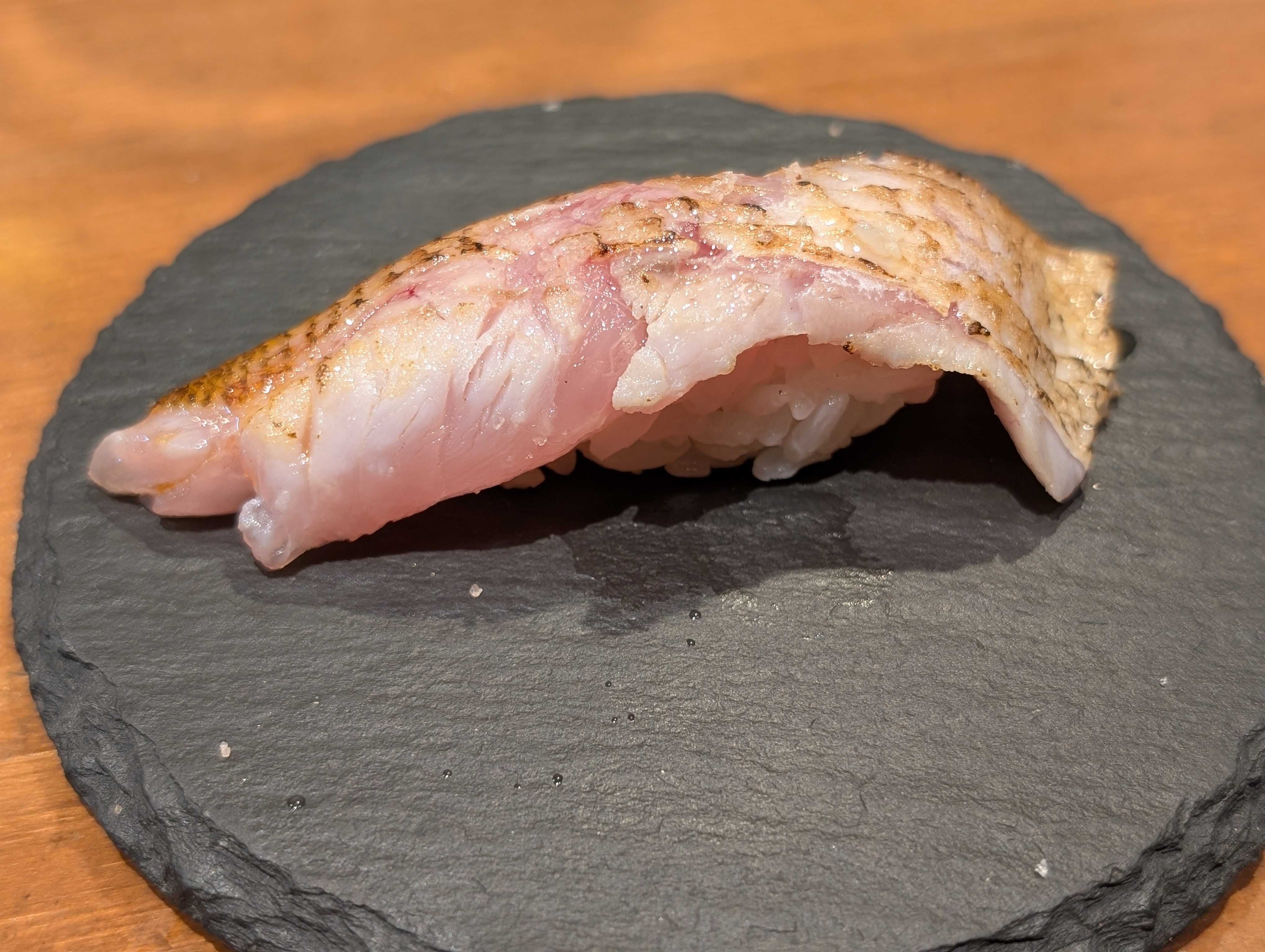
Hello, I’m Fujito, a sushi chef at REONA Sushi Tokyo.
Located in Kanda—Tokyo’s cultural heart of sushi—we offer more than just delicious sushi. At REONA, our guests enjoy an immersive experience where we explain the traditions, techniques, and culture of sushi in English. There is no other place quite like ours in all of Japan.
Now, let me ask you—have you ever heard of a fish called “Nodoguro”?
Nodoguro, also known as blackthroat seaperch, is a premium fish that has recently surged in popularity within Japan. While it only recently gained widespread recognition as a sushi topping, its rich and fatty flavor has earned it a central place on the sushi stage.
Despite its growing fame domestically, Nodoguro remains a hidden gem outside of Japan.
At REONA, when we ask guests which sushi from their omakase experience stood out the most, Nodoguro is frequently mentioned alongside favorites like tuna and uni.
In this article, I, Fujito, will walk you through the allure of Nodoguro and why it holds such great potential in the world of sushi.
 Nodoguro is a deep-sea fish primarily caught in the Sea of Japan—on the opposite side of the country from Tokyo, which faces the Pacific Ocean.
Nodoguro is a deep-sea fish primarily caught in the Sea of Japan—on the opposite side of the country from Tokyo, which faces the Pacific Ocean.
This prized fish is known for its rich, high-quality fat and deep umami flavor. It’s often called the “Toro of white fish” due to its luxurious mouthfeel. Although it’s most abundant in autumn and winter, Nodoguro is flavorful year-round and has been gaining increasing attention in the Edomae sushi world.
I still vividly remember my first bite of Nodoguro as an adult—the richness of the fat and the depth of flavor left a lasting impression.
Nowadays, dedicated Nodoguro restaurants are beginning to emerge across Japan, further spreading awareness of this incredible fish. If you're visiting Japan, it’s a must-try.
Nodoguro is rich in fat—much like otoro from tuna—but as a white fish, its natural flavor is more delicate. If not prepared properly, the richness of the fat can overpower the dish, leaving a heavy aftertaste.
To serve Nodoguro as sushi, chefs must highlight its subtle flavor while making the most of its luscious fat. That’s why aburi (light searing) is often the technique of choice. The degree of searing affects aroma and how the fat melts, making it a true showcase of a chef’s skill.
At REONA, we also adapt our techniques depending on the individual fish. When the fat content is more modest, we may even serve Nodoguro raw. This versatility makes it a fascinating ingredient to work with.
Nodoguro has long been appreciated in regions bordering the Sea of Japan, such as Kanazawa, Niigata, and the San'in area. However, in Tokyo—which faces the Pacific Ocean—this fish was relatively unfamiliar in the past.
As a deep-sea fish, Nodoguro is highly sensitive to changes in air and water pressure, making it unsuitable for long-distance transport. But with the advancement of freezing and distribution technology, high-quality Nodoguro is now available in Tokyo.
That said, Nodoguro is not traditionally part of the Edomae (Tokyo Bay) repertoire. I myself didn’t encounter it until adulthood.
Because of this, traditional Edomae techniques don’t include specific methods for preparing Nodoguro. Many long-established Edomae sushi restaurants still don’t serve it. However, at REONA—where we value innovation—we actively explore new techniques to bring out its full potential.
At REONA, we find that lightly searing Nodoguro before shaping it into nigiri offers the best experience.
This method is similar to how we treat otoro. By gently searing the fish, the fat melts slightly on the surface, creating a harmonious fusion with the sushi rice. As Nodoguro is a white fish, serving it raw can make the fat overpowering. Searing it enhances its sweetness and introduces a charred aroma, elevating the dish to new heights.
Among the various pieces served during an omakase course, Nodoguro stands out as a multi-sensory experience—it delights not only the palate but also the ears (sizzling sear), nose (toasty aroma), and even touch (warm, melt-in-your-mouth fat).
Like most sushi, Nodoguro pairs beautifully with soy sauce. Its bold flavor stands up well to even rich, dark soy, making for an exceptional match.
That said, at REONA we also serve Nodoguro without soy sauce, using only salt and citrus. This is one of my personal favorites. The salt enhances the natural umami and fragrance of the fish, while citrus cuts through the richness of the fat for a refreshing finish.
This balance of flavors represents REONA’s unique philosophy—merging tradition with innovation, and showcasing the refined aesthetics of Japanese cuisine.
At REONA, we have English-speaking service managers on hand to ensure international guests feel comfortable and informed throughout their experience. We provide in-depth explanations about Nodoguro’s preparation and background.
We also regularly visit Tokyo’s local markets to carefully select only the highest-quality Nodoguro.
This fish isn’t just a premium ingredient—it’s a symbol of the new wave of sushi, one that goes beyond traditional Edomae to embrace regional treasures from across Japan.
Here in Kanda—an area steeped in Edo-period culture—you’ll find a rare opportunity to experience sushi that harmonizes heritage and innovation. We invite you to savor a piece of Nodoguro that you would be hard-pressed to find anywhere else in the world.
REONA is not just a place to eat sushi—it’s a place to understand it. Through conversation with our chefs and detailed English explanations from our team, you’ll gain deeper insight into the techniques, culture, and history behind every piece.
Through Nodoguro, one of Japan’s rarest and most exquisite fish, we hope to deepen your appreciation of the world of sushi.